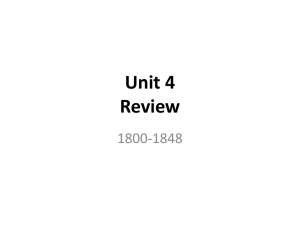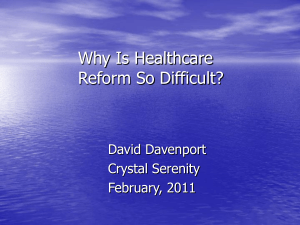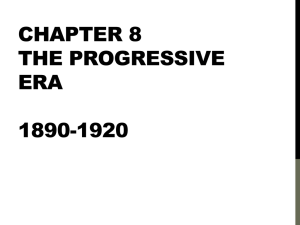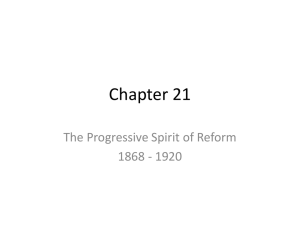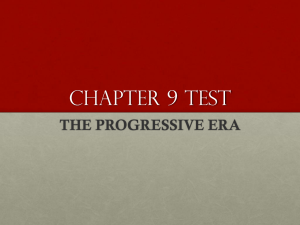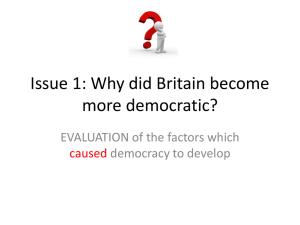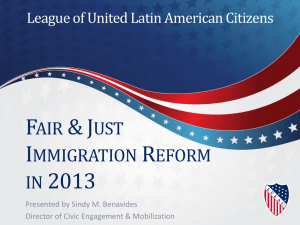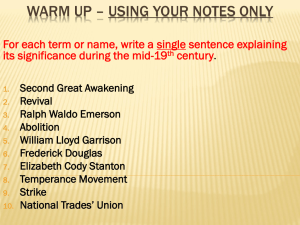1832 REFORM ACT - History @ St Benets
advertisement
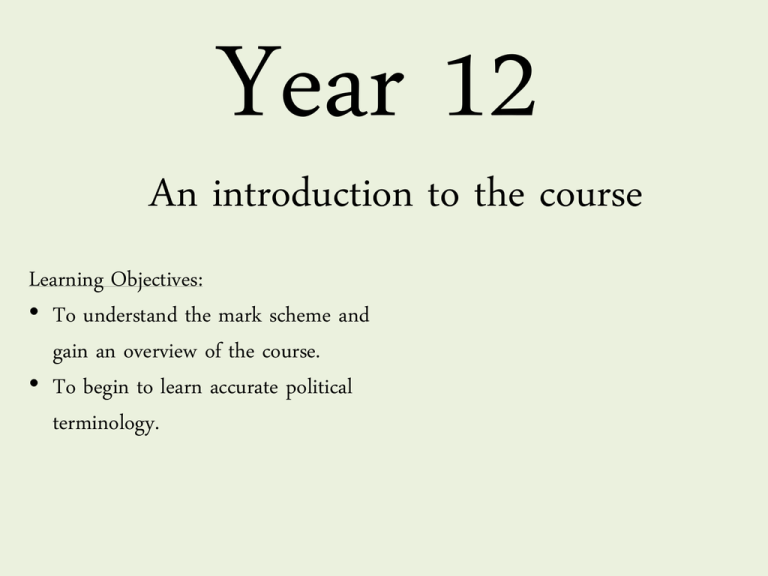
Year 12 An introduction to the course Learning Objectives: • To understand the mark scheme and gain an overview of the course. • To begin to learn accurate political terminology. Exam Paper • Look at the exam paper; are there any similarities to what you have done at GCSE? What similarities did we find? Exam Paper Look at the mark scheme you have been given. • Highlight the high level and find out what you need to do to get an A. • Write it down in you own words on your post it note in pairs. Exam Paper How do we succeed? What is the course like? What do we study? • Read the course overview you have been given. • Highlight any key themes/events/people we may be studying. What do you think we will be covering? What is the course like? What do we study? What do you think we will be covering? • A move towards democracy • The study of politicians and the impact they had • The opportunity to develop analytical skills by interpreting texts and sources. Tips from Year 13 • • • • • Be organised Use timelines Read around the topic Make your own notes Condense notes at the end of each topic • Revise! Revise ! Revise ! What knowledge do we need? Learning Objectives: • To make connections to our prior knowledge • To begin to learn accurate political terminology ? http://www.youtube.com/watch?v=ELDmySONQSE Circle map A. B. What is the topic? What do I know about the topic? C. What do I want to learn? D. What in my life experience is related to this topic? B A Politics B C D Terminology • • • • Different words New concepts Better understanding Look at the list of words and see if you can explain their meanings State Sovereignty Cabinet Consensus Coercion Government Society Franchise Democracy Elitism Legislature Executive Judiciary Oligarchy Common Law Constitution Meanings • Can you match the words to the definitions? • Which ones are you finding difficult to understand? How do we define Democracy and Dictatorship? Sort the words under the headings: which fit with your idea of a democracy and which fit with your idea of a dictatorship? • • • • • • • • • • Individual rights Liberty Hierarchy Action/force Duties Equality Freedom of thought/movement Suppression of thought/movement State Pacifism/discussion to settle political affairs Democracy • Individual rights rights • Liberty • Equality • Freedom of thought/ thought/ movement movement • Pacifism/ discussion discussion to settle settle political affairs • • • • Dictatorship Hierarchy Action/force Duties Suppression of of thought/ movement • The state A Question • What is the difference between a democracy and a dictatorship? • Is it better to live in a democracy or a Dictatorship? • Can you explain why? Lesson 2 Homework • Complete definitions of the following: Patronage Franchise Constituency Hustings Cooping Ballot Treating Peers Checks and Balances Constitution Rotten Borough Virtual Representation Electorate University Seats How do we use sources in the exam? Learning Objectives: • To practise our source skills • To enhance our understanding of the exam Looking back at your mark scheme for part a – what skills are you expected to display? • Reaches a judgement • Supported by careful examination of the sources • Sources are cross referenced • Elements of challenge and corroboration • Attributes of the source taken into account • Sources used in combination to answer ‘how far?’ Does source 1 suggest that the passing of the 1832 Reform Act brought about a significant reduction in the political influence of the aristocracy? Does source 3 suggest that the passing of the 1832 Reform Act brought about a significant reduction in the political influence of the aristocracy? How far do Sources 1 and 3 suggest that the passing of the 1832 Reform Act brought about a significant reduction in the political influence of the aristocracy? How far do Sources 1,2 and 3 suggest that the passing of the 1832 Reform Act brought about a significant reduction in the political influence of the aristocracy? How was Britain governed before 1832? Learning Objectives: • To understand what society was like before the 1832 Act was passed • To relate this to the Act of 1832 Society Each pair will be asked to look at one of the following areas: • • • • • • • • The aristocracy – Jacob and Fabian The Gentry – Katie and Hannah The Middle Classes – Warren and Daniel The Working Classes – Matthew, Jas and Millie The Church of England – Elizabeth and Catherine Growth in Population – Sophie and Rosie Collective action – Thomas, Kieran ] Non Conformity – Jacob and Bethany, Shirley Use chapter 1 to find out about your section of society. Read it on your own first then discuss it with your partner and agree the main points Work in pairs to complete this. Be ready to feedback to the class the main points. Society: summary You have 10 minutes to write a summary which answers the following questions • How was society changing? • What were the characteristics of the Middle and Lower Classes in 1830? • What were the characteristics of the Aristocracy and Gentry in 1830? • What elements of society were staying the same? • How does this help us understand why a Reform Act was passed in 1832? Why might Reform be needed? How was the way Britain was governed before 1832 unfair? Learning Objectives: • To understand what was wrong with the system of government before 1832 • To become familiar with political terms used Watch the clip from ‘Blackadder’ • What is it about? • What can it tell us? • Be ready to feedback http://www.youtube.com/watch?v=EOEMRXI3sRs What is the voting system like in 1832? A Question • Should people have to have qualifications in order to be able to vote? • What would you suggest ? Go back to your circle maps from our first lesson Is there anything you can now add about politics? Problems within the Unreformed Electorate Read chapter 2 from Heinemann ‘Extension of the Franchise’ and identify the abuses of the system. Be ready to feedback next session. Each table needs to divide up and research the following: Who was allowed to Vote (The electorate) (Shirley and Charlotte) • In the Counties • In the Boroughs - The distribution of Parliamentary Seats (Bethany) - Patronage (Hannah) - Who could be MP`s (Katie) Elections (Jacob) • Bribery • Expense • Uncontested • Pocket Boroughs • Rotten Boroughs Which problems were the biggest ? Which ones would be the easiest to solve ? What advice would you give to the government about what needs and what could be solved ? You have 3 minutes to discuss and be ready to tell me what you think and why Homework: What have you learned ? 1. Read Chapter 4 ‘The Great Reform Act of 1832’ and add to table of abuses. 2. Add the following terms to your glossary: • • • • • • • • • • • • • • Hierarchical society Labour aristocracy Established church Deference Monarch Franchise Elite Patronage Luddites Dissenters Laissez-faire approach Civil Service Coercion Cabinet How was Britain governed before 1832? Learning Objectives: • To consolidate understanding of the abuses of the system • To practice source skills Complete the true or false quiz on your desks. Answer the following questions using your knowledge from Chapter 2 Heinemann 1. 2. 3. 4. What would a “radical” want in the C19th? How could it be argued that Britain had a “balanced constitution”? What were the checks and balances in Britain`s political system? What did most politicians believe that the role of government was, in the C19th? 5. Who could vote before 1832? 6. What was meant by “virtual representation”? What have you understood ? • What were the “checks and balances” in Britain`s system? • What did a “radical” want? • What is meant by virtual representation? • Discuss these and decide on an answer Read the first page Chapter 2 The Unreformed Political System from ‘Government and Reform 1815-1918’ • What key point is he making? • Remember our key question: How was Britain Governed before 1832? (the unfairness of the system) Complete reading the Chapter Source Skills – What do we already know? • What should you do first when you get a source? • NOP? • How do you write about sources? Sources! An essential skill! • Read Source 1 and highlight any words you do not understand. • Look at the Nature, Purpose, Origin of Source A; what extra details does that give you ? • Nature – what it is (memo, speech, newspaper article) • Purpose – why it was written, said; who it was intended for. • Origin – who wrote it / said it ? Do you know anything about them ? Repeat for the other sources Nature Origin Purpose What can you infer about reasons for supporting Parliamentary Reform from this source? Nature Origin Purpose What can you infer about reasons for supporting Parliamentary Reform from this source? Nature Origin Purpose What can you infer about reasons for supporting Parliamentary Reform from this source? Study Sources 1, 2 and 3. How far do Sources 2 and 3 support the reasons given in Source 1 for supporting Parliamentary Reform ? (20 marks) Task: Compare the sources you have been analysing. In one colour note any similarities between the sources. In another colour note any differences between the sources. Source 1 Source 1 Source 2 Source 3 Source 2 Source 3 Both source 1 and 3 are referring to a “measure of conservation” (1) and “resistance to further innovation” (3). Both sources are supporting Parliamentary reform as a means of controlling the level of change and ensuring power is maintained by the ruling classes. Explain why the aristocracy might not want reform and feel justified in resisting it? What were the motives for reform before 1832? Learning Objectives: • To learn about the beliefs of Whigs and Tories • To begin to understand why some people might want to reform and to link this to political affiliations Sit in the following groups: • • • • • Group 1: Jacob Arkell, Catherine, Bethany, Warren Group 2: Thomas, Shirley, Jas, Daniel Group 3: Jacob Atwell, Hannah, Elizabeth Group 4: Millie, Rosie, Kieran, Charlotte Group 5: Fabian, Sophie, Katie, Matthew In groups use Chapter 2 to complete the task Card Sort • Stay in your groups and work on the cards to sort the arguments into a table; those for reform and those against Stay in your groups and use the cards to sort the arguments into a table; those for reform and those against. For Reform Against Reform Stay in your groups and use the cards to sort the arguments into a table; those for reform and those against. For Reform • • • • • • • • • • • Government should represent all the nation not just a few of the privileged. Laws and government are not valid to today. A little reform will prevent revolution. Rotten boroughs are wrong. Counties and boroughs are unrepresentative of those who live there. Government is corrupt and needs to be reformed. Reform of the electoral system will bring benefits to all of British life. Working men are not represented. Men of property and social standing have their own agenda. It should be the governments job to provide happiness to the people – utilitarianism. Industrial towns are not represented but small villages are over represented. Against Reform • • • • • • • • • • • • MPs represent the whole nation Parliament is more representative than it has ever been. There is nothing wrong with the constitution – it has worked so far and the rest of the world envies it. A little bit of reform makes people want more. There are already riots. France! Rotten boroughs allow vital MPs to be elected – MPs that represent property, church and universities. All people are entitled to a vote. Change should be natural and growth should be gradual. The constitution is a whole not simply changing certain parts. It is a trick – people will not be better represented. The men elected will not have our interests at heart. Propertied and landed classes will help the lower classes – they are natural rulers. If towns don’t have an MP it saves them the expense of an election. Arguments • Can you explain each argument? • Choose the strongest argument in favour of reform and the strongest against reform. Mini Debates! • • • • • • Group 1: Jacob Arkell, Catherine, Bethany Group 2: Thomas, Jas, Daniel Group 3: Jacob Atwell, Hannah, Elizabeth Group 4: Millie, Rosie, Kieran, Charlotte Group 5: Fabian, Sophie, Katie, Group 6: Warren, Shirley, Matthew Task: you will have 3 minutes to prepare a mini debate. The roles are as follows: • Purple = debate judge • Green = FOR reform • Red = AGAINST reform After your 3 minutes the Greens will get 1 ½ minutes to put forward their argument FOR reform. After the time the judges must stop the greens and the reds will get 1 ½ minutes to put forward their argument AGAINST reform. The judges must then make a decision and reward a prize to the best argument! Mini-debate guide sheet Follow the following advice for planning your debate (the judges will use this checklist when making their decisions): o Did they give their strongest argument first? o Were they able to back up arguments with evidence/explanations? o Did they reference the political system before 1832 to support/challenge reform? o Did they give at least 3 strong arguments in all? o Were they able to ‘fill’ the allocated time or did they stop early? o Did they find it difficult to explain their points? o Were you convinced of their argument? Judges must complete this check list when the debate is taking place and may add comments afterwards. FOR reform: oDid they give their strongest argument first? oWere they able to back up arguments with evidence/explanations? oDid they reference the political system before 1832 to support/challenge reform? oDid they give at least 3 strong arguments in all? oWere they able to ‘fill’ the allocated time or did they stop early? oDid they find it difficult to explain their points? oWere you convinced of their argument? Other comments: Judges must complete this check list when the debate is taking place and may add comments afterwards. AGAINST reform: oDid they give their strongest argument first? oWere they able to back up arguments with evidence/explanations? oDid they reference the political system before 1832 to support/challenge reform? oDid they give at least 3 strong arguments in all? oWere they able to ‘fill’ the allocated time or did they stop early? oDid they find it difficult to explain their points? oWere you convinced of their argument? Other comments: Judges must complete this check list when the debate is taking place and may add comments afterwards. FOR reform: oDid they give their strongest argument first? oWere they able to back up arguments with evidence/explanations? oDid they reference the political system before 1832 to support/challenge reform? oDid they give at least 3 strong arguments in all? oWere they able to ‘fill’ the allocated time or did they stop early? oDid they find it difficult to explain their points? oWere you convinced of their argument? Other comments: Judges must complete this check list when the debate is taking place and may add comments afterwards. AGAINST reform: oDid they give their strongest argument first? oWere they able to back up arguments with evidence/explanations? oDid they reference the political system before 1832 to support/challenge reform? oDid they give at least 3 strong arguments in all? oWere they able to ‘fill’ the allocated time or did they stop early? oDid they find it difficult to explain their points? oWere you convinced of their argument? Other comments: Judges must complete this check list when the debate is taking place and may add comments afterwards. FOR reform: oDid they give their strongest argument first? oWere they able to back up arguments with evidence/explanations? oDid they reference the political system before 1832 to support/challenge reform? oDid they give at least 3 strong arguments in all? oWere they able to ‘fill’ the allocated time or did they stop early? oDid they find it difficult to explain their points? oWere you convinced of their argument? Other comments: Judges must complete this check list when the debate is taking place and may add comments afterwards. AGAINST reform: oDid they give their strongest argument first? oWere they able to back up arguments with evidence/explanations? oDid they reference the political system before 1832 to support/challenge reform? oDid they give at least 3 strong arguments in all? oWere they able to ‘fill’ the allocated time or did they stop early? oDid they find it difficult to explain their points? oWere you convinced of their argument? Other comments: Whigs and Tories • How different are these 2 parties? • What impact will their views have on the possibility of reform? A Question • What is the difference between Direct Democracy and Indirect Democracy? • Is Indirect Democracy effective? • Are there any problems with Direct Democracy? Terminology • • • • • Veto Hustings Constituency Treating Cooping Homework • Complete 20 mark question on reasons for reform. What were the motives for reform before 1832? Assessment Week Learning Objectives: • To practice our source skills • To look further into the motives behind reform • To apply our knowledge from last lesson Question A (20 marks) Structure • Start with source 1 – identify viewpoint, link to the question, use direct quotations from the source to support point, use NOP to identify weight (strength) that should be given to argument of the source, end paragraph with an interim conclusion/link to question – therefore is suggests… • The next paragraph should focus on the source which SUPPORTS the view of source 1. This is supported by … What similarities can you find. Focus on answering the question and making direct comparisons. • The third paragraph should deal with the final source and look for any areas of challenge (differences), making sure you make direct comparisons to the other sources. Always link back to answering the question. • Write a conclusion to the question – what judgement have you reached? How have you reached that? They are looking for the view of the sources overall. • Time allowance: 20 minutes to write. 5 minutes to work with the sources. • Aim for 1 and a half pages. Study Sources 1, 2 and 3. How far do Sources 2 and 3 support the arguments given against reform in Source 1. Explain your answer using the evidence of Sources 1, 2 and 3. (20 marks) Advice: 1. Read the question; highlight the key words and check you understand what the question is about. What claim or view is being put forward? 2. Often the question asks whether 2 sources agree or disagree with 1 source. You should expect to find agreement / disagreement. 3. Start with the first source; read it and highlight the key points so you know what it is saying and what it is implying. Does this source agree or not with the claim in the question? Does it have more than 1 point of view? (Perhaps make a list of points for /against the claim.) 4. Think about the context of the source; what do you know about the period in question? What was happening at the time? Does the source refer to anything you recognise? 5. What about the provenance of the source? Remember, Nature, Purpose, Origin. How does this affect the strength of the evidence? 6. Now look at the next source and repeat the process. However, look for examples of where these 2 sources agree or where they conflict; does this 2nd source help to explain anything in the first? 7. Now repeat this process with the next source and so on. 8. Take a moment to look at all the evidence you have collected; how convincing is it? How does it back-up the claim in the question? SOURCE 1 (From Sir Robert Inglis on the un-reformed House of Commons, 1March 1832) Our Constitution is not the work of a code-maker; it is the growth of time and events beyond the design or the calculation of man. … there is … no evidence that our House was ever selected upon any principle of a Representation of population, or upon any fixed principle of Representation whatever …. Such … as the House of Commons is now, it has been for a long succession of years: it is the most complete representation of the interests of the people, which was ever assembled in any age or country. It is the only constituent body … which comprehends within itself, those who can urge the wants and defend the claims of the landed, the commercial, the professional classes of the country; those who are bound to uphold the prerogatives of the Crown, the privileges of the nobility, the interests of the lower classes, the rights and liberties of the whole people. Nature: Origin: Purpose: Argument given against reform? SOURCE 2 - (From a cartoon by Cruikshank, 1831, called “The System that Works so well” St Stephens refers to the House of Commons. “The System works well!! Why should it be altered ?!! We want no Reform – nothing can be better than the present System – why not let well alone ?!! We are indebted to this System for all the blessings we enjoy ! We must defend our Glorious Constitution !!” SOURCE 3 (Lord Palmerston`s view, 3 March 1831; joined the Whigs in the 1830`s) Any man who looked at the workings of the present system must see, that there were five great and peculiar blemishes, which it was necessary to remove, in order to fit it for the intelligence and feelings of the times in which we lived. The first … was the system of nomination by the patrons of boroughs; the second, the gross and barefaced corruption which prevailed among the lower classes, when their votes became necessary to the higher; the third, the absence of all adequate balances of representation with respect to the great manufacturing and commercial towns; the fourth, the great expense of elections: and the fifth, the very unequal and unjust distribution of the power of voting among the middle and lower classes. Nature: Origin: Purpose: Argument given against reform? Nature: Origin: Purpose: Argument given against reform? SOURCE 1 (From Sir Robert Inglis on the un-reformed House of Commons, 1March 1832) Our Constitution is not the work of a code-maker; it is the growth of time and events beyond the design or the calculation of man. … there is … no evidence that our House was ever selected upon any principle of a Representation of population, or upon any fixed principle of Representation whatever …. Such … as the House of Commons is now, it has been for a long succession of years: it is the most complete representation of the interests of the people, which was ever assembled in any age or country. It is the only constituent body … which comprehends within itself, those who can urge the wants and defend the claims of the landed, the commercial, the professional classes of the country; those who are bound to uphold the prerogatives of the Crown, the privileges of the nobility, the interests of the lower classes, the rights and liberties of the whole people. Study Sources 1, 2 and 3. How far do Sources 2 and 3 support the arguments given against reform in Source 1. Explain your answer using the evidence of Sources 1, 2 and 3. (20 marks) SOURCE 2 - (From a cartoon by Cruikshank, 1831, called “The System that Works so well” What similarities can you find between the sources? SOURCE 3 (Lord Palmerston`s view, 3 March 1831; joined the Whigs in the 1830`s) Any man who looked at the workings of the present system must see, that there were five great and peculiar blemishes, which it was necessary to remove, in order to fit it for the intelligence and feelings of the times in which we lived. The first … was the system of nomination by the patrons of boroughs; the second, the gross and barefaced corruption which prevailed among the lower classes, when their votes became necessary to the higher; the third, the absence of all adequate balances of representation with respect to the great manufacturing and commercial towns; the fourth, the great expense of elections: and the fifth, the very unequal and unjust distribution of the power of voting among the middle and lower classes. What differences are there between the sources? You now have 20 minutes to complete your assessment. You must: • Refer directly to sources • Follow the structure advice given • Write 1 ½ sides • Discuss each source • Compare and contrast sources in detail • Reach a judgement about the overall (all 3 sources) judgement of the sources When you have finished: • Complete a hand in sheet. • Highlight each comparison. • Use your mark scheme and say which level you think your essay should be and why. What was the sequence of events that led to reform in 1832? Learning Objectives: • To understand the complex nature of politics leading up to 1832 • To develop research skills and understanding of chronology What was the sequence of events that led to reform in 1832? In order to understand the sequence of events that led to the passing of the Reform Act, it is necessary to construct a timeline, showing key events and key people. For each item below there needs to be an explanation of what it is/means; you are seeking to identify how and why it was passed. Resources you will need: Britain text book, Chapter 6, pages 112-116 Chapter 4, Why did Parliament Reform itself? Dates you need to include: Feb 1827 April 1827 Aug 1827 Jan 1828 Jan 1830 Nov 1830 March 1831 April 1831 Sept 1831 Oct 1831 Dec 1831 March 1832 May 1832 June 1832 Key people/events to include Thomas Attwood Lord Grey Charles X Catholic Emancipation Death of George IV Lovett & Hetherington Lord John Russell General Election Bristol Riots “Go for Gold” Duke of Wellington Lord Liverpool Pick out the top 3 events/people that you think had the most impact on the passing of the Reform Bill and explain why. Sit in the following groups Group 1 Elizabeth, Hannah, Matthew Group 2 Thomas, Jas, Rosie Group 3 Catherine, Kieran, Fabian Group 4 Jacob Arkell, Shirley, Katie Group 5 Warren, Daniel, Charlotte, Bethany Group 6 Jacob Atwell, Sophie, Millie How near was Britain to revolution? Learning Objectives: • To learn about the High / Low politics model of change • To explore the theory that reform was passed because of fear of revolution This is a cartoon by John Doyle; it shows the British Public helping Earl Grey at the top; William IV is in the middle and the Duke of Wellington at the lower end. John Doyle`s pictures were in the Times from 1829-1851; he produced commentaries on political events. Is it arguing for High or Low Politics? How does change happen? Low Politics – pressure from outside Parliament to force change on the government High Politics - competition between parties / politicians; change happens because of actions within Parliament Add these terms to your glossary Using your timeline what evidence can you find for either of these 2 models? Which one is the most convincing? Question B Do you agree with the view that the Reform Act was passed because Britain came very close to revolution between 1830 and 1832? (40 marks) Work in pairs and complete the following task: • Read the materials provided (Chapter 4 ‘The Whigs and the Reform Bill, ‘The Campaign in the country, ‘Was Britain on the brink of revolution 1830-32?’) • Research arguments for both sides • Complete table of notes as below Yes Britain was near to Revolution It is essential to use Historians views to back up your argument so ensure you make a note of these. No Britain was not near to Revolution The class will be divided into 2 groups: 1. The first group will prepare an argument for the case against revolution 2. The second group will prepare an argument in favour of revolution 3. I will choose 2 students who will observe the rest of the class and will be the ones to come to a final decision about which case is the strongest and who proved their case best. How near was Britain to revolution? The case in favour of revolution The case against revolution You have the rest of this lesson and then homework to prepare for this debate. You will need to produce: • an introductory statement • ¾ strong arguments • Counter arguments • A closing statement Britain was not close to Revolution Britain was close to Revolution • • • • • • • • • • • • • • • 1830 – there were disturbances in South-East (Swing Riots) Oct 1831 the defeat of 2nd Reform Bill caused widespread unrest; E.P. Thompson (Marxist) argues Britain WAS near to revolution. Pressure from BPU (Birmingham Political Union) Pressure from Francis Place (English Social Reformer) against the Lords. Violent Protests in the country – members of the Lords attacked. Anglican Bishops attacked Large scale incidents in London, Derby, Nottingham and Bristol. May 1832 – May Days crisis – demos in London and Birmingham Widespread economic distress Deep divisions within ruling classes Well-organised radical movement Members of political unions were armed Call for a run on the banks and non-payments of taxes Influence of a successful revolution in Paris July 1830 Middle class were “riding the tiger” • • • • • • • • Swing Riots were dealt with swiftly and effectively and were NOT an attempt at revolution The Whigs showed their commitment to reform The government kept its resolve: they did not use repression to quell the movement for reform Middle and working classes were united ion the BPU; Attwood and Place were alarmed by the violence and did not want to lead a revolution , but they played up the agitation to get reform (bluff) The violence split the middle and working classes The decision to let the 3rd Bill through the Lords diffused the situation The radical movement was deeply divided with class antagonisms between middle and working classes – especially in the North! The PERCEPTION was that there was a danger of revolution. What led to reform in 1832? Homework The objective of this exercise is to learn about and evaluate early attempts at reform. You will need pages 40-57 of ‘The Extension of the Franchise’. 1. Assess Wilkes` contribution to the reform movement. 2. What did Cartwright develop? 3. What exactly did Thomas Paine advocate? 4. What did Burdett and Cochrane do that was so different? 5. What did Francis Place believe? Then, explain, in your own words, why the movement for reform started up again after 1815; in your view what was achieved? How near was Britain to revolution? Learning Objectives: • To learn how to plan a (b) question • To review content for the key question Watch the following clip • Which model of change does this show? • Can you link this to our time period? • Can you link this to our Key Question? http://www.youtube.com/watch?v=vfINMJBwcU Fishbone Diagram • In order to review what we have learned about the Reform Act of 1832 we will focus on causes. • On post-it`s write down as many causes for the Reform Act being passed as you can think of. • Now group them together into categories. • Complete the Fishbone Diagram Fish bone - In order to review what we have learned about the Reform Act of 1832 we will focus on causes. - Write down as many causes for the Reform Act being passed as you can think of on paper - Now group them together into categories. - Complete the Fishbone Diagram Reform Act Key skill: classification of causes Fish bone - In order to review what we have learned about the Reform Act of 1832 we will focus on causes. - Write down as many causes for the Reform Act being passed as you can think of on paper - Now group them together into categories. - Complete the Fishbone Diagram Whigs wanted reform to preserve Fear of riots Cause 1 Cause 1 Cause 2 Cause 2 Reform Act 1832 Cause 2 Cause 2 Cause 1 Cause 1 To correct abuses The precedent had already been set Key skill: classification of causes Fish bone - In order to review what we have learned about the Reform Act of 1832 we will focus on causes. - Write down as many causes for the Reform Act being passed as you can think of on paper - Now group them together into categories. - Complete the Fishbone Diagram Whigs wanted reform to preserve Fear of riots Pressure from the BPU especially after October 1831; they intended to put themselves on a military footing in November 1831 The Whigs showed their commitment to reform Revolutions often occur when there is economic distress. 1830 There had already been disturbances in the southeast (Swing Riots) Cause 2 Violent protests in the country – members of the Lords attacked and Anglican Bishops attacked. Reform Act 1832 Cause 2 Cause 2 Cause 1 Cause 1 To correct abuses The precedent had already been set Key skill: classification of causes Causes of 1832 Reform Act • Now you have reasons why the Reform Act was passed and the question asks you to make up your mind about which ones are most important. • There are 2 views (High / Low Politics) so you know that the sources will represent these. • Look at Sources 4 and 5 and decide what view they each hold. • • • • • • • • • • • • • • • • • • • • Yes – near to Revolution Revolutions often occur when there is economic distress 1830 There had already been disturbances in the south-east (Swing Riots) Oct 1831 The defeat of the 2nd Reform Bill caused widespread unrest; E.P. Thompson (Marxist) argues Britain was near to revolution. Pressure from the BPU especially after October 1831; they intended to put themselves on a military footing in November 1831 Pressure from Francis Place against the Lords; he drew up a plan of resistance in 1832 Middle classes and working classes were united Violent protests in the country – members of the Lords attacked. Anglican Bishops attacked Large scale incidents in London, Derby, Nottingham and Bristol; Nottingham Castle burnt down !Bristol riots lasted for 3 days and Bishop`s palace burnt down. Troops had to be used May 1832 May Days crisis; demos in London and Birmingham; the regiments were ordered to “rough-sharpen their swords” Widespread economic distress Deep division within the ruling classes Well-organised radical movement Members of the political unions were armed Call for a run on the banks and non-payment of taxes. Influence of a successful revolution in July 1830 in Paris. Attwood said he “would rather die than see the Great Bill of Reform rejected” Middle class were “riding the tiger” The Times warned the aristocracy in 1831 not to resist the people. Earl Grey warned the House of Lords about the people who No – not close to Revolution • • • • • • • • • Swing Riots were dealt with swiftly and effectively (9 hung) and were not an attempt at revolution The Whigs showed their commitment to reform The government kept its resolve; they did not use repression to quell the movement for reform Middle and working classes were united in the BPU; Attwood and Place were alarmed by the violence and did not want to lead a revolution, but they played up the agitation to get reform (bluff) The violence split the middle and working classes The riots in Bristol were put down swiftly with 12 deaths and hangings The decision to let the Third Bill through the Lords diffused the situation The radical movement was deeply divided with class antagonisms between the middle and working classes, especially in the north The perception was that there was a danger of revolution Read the advice sheet for a (b) question What is important to remember? Question (b) • Do you agree with the view that the Reform Act was passed because Britain came very close to revolution between 1830 and 1832 ? (40) • This question is really asking you about causes. Read and carefully annotate the sources from question (b) It is important to lead from the sources and to reinforce the argument with your own knowledge. Question (b) • Your introduction should reflect this knowledge. • Take a few moments to write one. Question (b) • The focus of this question is to show awareness of the context of the 1832 Act and that there are different views about it. • To score high marks you need to give both sides and then reach a judgement. Look back at your mark schemes and advice sheet. • Each point in the sources must be developed using your own knowledge. Put in as much as you can! • You must lead with the sources and support them with your own knowledge – not the other way round. • Use points of view from historians if you can to back-up your answer. Yes – near to revolution • Revolutions often occur when there is economic distress • 1830 There had already been disturbances in the south-east (Swing Riots) • Oct 1831 The defeat of the 2nd Reform Bill caused widespread unrest; E.P. Thompson (Marxist) argues Britain was near to revolution. • Pressure from the BPU especially after October 1831; they intended to put themselves on a military footing in November 1831 • Pressure from Francis Place against the Lords; he drew up a plan of resistance in 1832 • Middle classes and working classes were united • Violent protests in the country – members of the Lords attacked. • Anglican Bishops attacked Yes • Large scale incidents in London, Derby, Nottingham and Bristol; Nottingham Castle burnt down !Bristol riots lasted for 3 days and Bishop`s palace burnt down. Troops had to be used • May 1832 May Days crisis; demos in London and Birmingham; the regiments were ordered to “rough-sharpen their swords” • Widespread economic distress • Deep division within the ruling classes • Well-organised radical movement • Members of the political unions were armed Yes • Call for a run on the banks and non-payment of taxes. • Influence of a successful revolution in July 1830 in Paris. • Attwood said he “would rather die than see the Great Bill of Reform rejected” • Middle class were “riding the tiger” • The Times warned the aristocracy in 1831 not to resist the people. • Earl Grey warned the House of Lords about the people who were “roused and agitated” • Eric Evans argues that Britain was close to revolution No • Swing Riots were dealt with swiftly and effectively (9 hung) and were not an attempt at revolution • The Whigs showed their commitment to reform • The government kept its resolve; they did not use repression to quell the movement for reform • Middle and working classes were united in the BPU; Attwood and Place were alarmed by the violence and did not want to lead a revolution, but they played up the agitation to get reform (bluff) No • The violence split the middle and working classes • The riots in Bristol were put down swiftly with 12 deaths and hangings • The decision to let the Third Bill through the Lords diffused the situation • The radical movement was deeply divided with class antagonisms between the middle and working classes, especially in the north • The perception was that there was a danger of revolution How great was the Reform Act? Learning Objectives: • To evaluate the Reform Act of 1832 • To begin to plan for a debate THIS COLUMN WAS ERECTED IN 1838 TO COMMEMORATE THE SERVICES RENDERED TO HIS COUNTRY BY CHARLES EARL GREY K.G. WHO, DURING AN ACTIVE POLITICAL CAREER OF NEARLY HALF A CENTURY WAS THE CONSTANT ADVOCATE OF PEACE AND THE FEARLESS AND CONSISTENT CHAMPION OF CIVIL AND RELIGIOUS LIBERTY. HE FIRST DIRECTED HIS EFFORTS TO THE AMENDMENT OF THE REPRESENTATION OF THE PEOPLE IN 1792, AND WAS THE MINISTER BY WHOSE ADVICE, AND UNDER WHOSE GUIDANCE, THE GREAT MEASURE OF PARLIAMENTARY REFORM WAS AFTER AN ARDUOUS AND PROTRACTED STRUGGLE SAFELY AND TRIUMPHANTLY ACHIEVED IN THE YEAR 1832. How great was the Reform Act? In groups of 3 use your table to assess how far the abuses of the unreformed system had been addressed by the 1832 Reform Act. Use the following resources to help you: • The Extension of the Franchise 1832-1931, Chapter 5 ‘What was the Impact of the Reform Act?’ • Reforming Britain 1815-50, Chapter 5, ‘What was the importance of the Great Reform Act?’ • The Extension of the Franchise 1832-1931, Chapter 4, ‘Why did Parliament vote to reform itself?’ (you should already have this in your files) • • • More than doubled 68% increase Middle classes benefitted esp. shopkeepers • • Only 2 sets of qualification – county and borough Increase in urban qualification • • • • • • • • 56 rotten/pocket boroughs lost both their MPs 30 small boroughs lost 1 MP • • • • 74% seats contested • • • • Counties – 40 shilling freeholders Majority of working class couldn’t vote Less than before 1832 • • • • Some industrial towns e.g. Doncaster still had no representation University seats remained London still under represented • Patronage remained (tenant farmers) – intimidation No secret ballot Bribery and corruption got worse No limit on election expenses • • • • • Only men could vote 1/5 of men in counties could vote 478,000 – 800,000 8% population could vote Boroughs £10 franchise meant an increase in middle class voters Little change for working classes Conservative change! North under represented and South over 19 new boroughs created with 1 MP (20 with 2 MPs) More county seats 70 pocket boroughs remained Average % of contested election increased from 38% to 59% New voters in tenant farmers How great was the Reform Act? In groups of 3 use your table to find evidence to back up the statement you have been given. Discuss in your groups and be ready to feedback to the class. Use the following resources to help you: • The Reform Act solved all abuses • The Reform Act solved none of the abuses • The Act addressed some abuses that existed Was the Reform Act great? Homework What was the impact of the Reform Act on politics? Learning Objectives: • To build on our understanding of political parties • To investigate further the impact of the 1832 Reform Act Quick Quiz 1. What does patronage mean? The support given by a patron. The power to control appointments to office or the right to privileges. 2. Who are the Whigs? Believed in reducing the powers of monarchy and primacy of H of C, supported demands of nonconformists. 3. Who are the Tories? Traditional defenders of the rights of the monarchy and the Church of England. (Irish word for bandit). 4. What does enfranchised mean? To be given the right to vote. 5. What is a constitution? A body of fundamental principles or established precedents according to which a state or other organization is acknowledged to be governed. What was the impact of the Reform Act on politics? Make notes as a team and be ready to feedback The Liberals The Conservatives The Monarchy Decline of Patronage and part reorganisation Impact of Reform Act The Liberals • Divisions in Whigs – Irish Catholics/Radicals – Grey found it difficult to control – King dismissed Whig ministers 1834 and invited Peel to form gov. (Conservative) • Lichfield House Compact – alliance between Whigs (Lord Melbourne), Irish and Radicals to get rid of Conservatives • Gash “within 10 years of Reform Act politics was dominated by two major parties to an extent previously unknown” • 1841 – common for newspapers to report election results in terms of Liberal and Conservative gains or losses. The Conservatives • First party to declare attempts to broaden appeal • Peel recognised the need to appeal to the newly enfranchised Middle Classes • Tamworth Manifesto of 1834 – declared his acceptance of Reform Act as “a final and irrevocable settlement of Great Constitutional question” • Restated Tory conviction “the respect for ancient rights and the deference to prescriptive authority” • Peel setting out the guiding principles for a new Conservative Party • Prepared to consider cautious and limited changes where necessary. Patronage • Royal Patronage had been steadily reduced by a programme of Economic Reform • Aristocratic Patronage suffered a severe blow from the abolition of many rotten boroughs • Party Organisation was therefore more important now than patronage Impact of Reform Act The Monarchy • 18th century monarchs had power to appoint and dismiss ministers e.g. George III 1783 dismissed FoxNorth coalition and placed Pitt as PM. However in 1834 when William IV dismissed Whig ministry in favour of Peel things had changed and Peel was unable to form a secure government. After 100 days he had to admit defeat . • Monarch could no longer sustain ministers through patronage • Public opinion and party politics were what mattered. Part Organisation • Voters now had to be registered • Parties therefore had to ensure voters were registered • Establishment of local political associations and registration committees and local party agents • Party Organisation at Westminster also became important – Tories established Carlton Club in 1832, and Whigs established Reform Club in 1836 • Links between central organisations and local committees were loosed as was party discipline How much was the political system altered by the 1832 Reform Act? What had CHANGED? What was left UNCHANGED? How much was the political system altered by the 1832 Reform Act? What had CHANGED? • 145 borough seats abolished • New seats awarded to towns/cities in industrial towns • Uniform franchise • Increased electorate 490,000 – 800,000 • Increased middle class electorate • Number of seats controlled by House of Lords reduced • Power of House of Lords no longer seemed so formidable • Increase in contested elections • Registration of voters What was left UNCHANGED? • 70 pocket borough remained • Still huge difference in size of electorates – 31 boroughs less than 300 and others had thousands • Rural south over represented relative to industrial north • Ownership of property was still basis of franchise – vast majority of working class excluded • Less than 20% adult males could vote • Landlords (many aristocratic) continued to exert influence • Most ministers still aristocratic and all PM apart from Sir Robert Peel • Few industrialists entered Parliament – too busy and no payment • No secret ballot – corruption continued Is it Great? http://www.youtube.com/watch?v=YGtO60EzC6 Q Watch this clip to see what the point of view of the working classes was after the Reform Act was passed. The working classes • The Whigs made no attempt to deny that the £10 franchise qualification was designed to exclude the lower classes from the vote. • The National Union of the Working Classes said, “ … the Bill is a mere trick to strengthen the towering exclusiveness of our blessed constitution”. The middle classes • • • • How did they fare ? The job of an MP carried no salary. There was no middle class party created. The middle classes seemed to prefer to get involved in local politics. How great was the Reform Act? • Structure of the Debate • The 2 lead speakers present their key opening arguments. No more than 5 minutes each. They can read from notes. • No-one is allowed to interrupt them How great was the Reform Act? • Then anyone can make a point – either to raise a new point or to reinforce a previous point with new evidence. • Or – they can refute a point made by the opposing team using evidence to support. • No personal insults are allowed. • Notes can be used. • Higher points are gained by using historians` views. How great was the Reform Act? • For each person who does not make a contribution to the debate – 1 mark will be deducted. • Members of the team can make as many contributions as they wish. • Team members can give evidence to the team leader • At the end of the debate, each leader will have a chance to summarise their key arguments. Debate Teams The Reform Act WAS great The Reform Act WAS NOT great Thomas Jacob Arkell Daniel Jas Elizabeth Charlotte Fabian Katie Rosie Millie Catherine Hannah Kieran Shirley Jacob Atwell Sophie Bethany Warren Matthew Was the Reform Act great? Learning Objectives: • To evaluate the importance of the Reform Act and to re-focus your thinking on the impact • To look at the impact of the Act in terms of the growth of political parties The Impact of the Reform Act of 1832 • Classify the following statements as Positive results / Negative Results / Other Read ‘The Extension of the Franchise’, Chapter 6 page 82-85 • Highlight and annotate any key points about the impact of the Reform Acton the nature and development of Political Parties. Development of political parties • • • • The Whigs The Tories The role of the monarchy The Conservatives winning the election in 1841 Impact on Parties Whigs Tories Whigs set up the Reform Club in 1836 1832 The Carlton Club acted as Conservative Central Office Whigs made an alliance with Irish and Radicals in 1834 (Lichfield House Compact); by 1841 known as Liberals. A manifesto was published (Tamworth) setting out policies Whigs had seen 1832 as a vote winner and did win the first election after 1832 with a majority of 308 Recognised that the Party needed to widen its support Registration of voters meant local political organisations were important Registration of voters meant local political organisations were important Other effects • In your group compile a list of other effects • Be prepared to feedback to the class Other Effects • • • • • • • Less corruption? More representation? Stability? Dominance of House of Commons? Decline of influence of the Monarchy? Reduction in patronage? Effect on the working classes? Complete debate preparations You should: • Focus on a range of impacts of the Reform Act (positive/negative) • Assess the impact on different groups (political parties/monarchy/aristocracy/ middle classes/working classes) • Support your point with specific evidence • Support your argument with historical interpretations. • Ensure your opening and closing speeches are relevant and persuasive Do you agree with the view that the Reform Act of 1832 was ‘great’? • WAS ‘great’ – argument and evidence in support • NOT ‘great’ – argument and evidence in support • Come to a conclusion Do you agree with the view that the 1832 Reform Act was a conservative measure with limited effects? Learning Objectives: • To identify the key areas of a question b mark scheme • To be aware of success criteria and structure for a 40 mark question • To analyse sources and apply contextual knowledge to them (b) (i) Use Sources 4, 5 and 6 and your own knowledge. Do you agree with the view that the 1832 Reform Act was a conservative measure with limited effects? Explain your answer, using Sources 4, 5 and 6 and your own knowledge. (40) Part (b) Target: AO1a & AO1b (10% - 24 marks) Recall, select and deploy historical knowledge appropriately, and communicate knowledge and understanding of history in a clear and effective manner. What are you being asked to do? AO2b (7% - 16 marks) Analyse and evaluate, in relation to the historical context, how aspects of the past have been interpreted and represented in different ways. What are you being asked to do? (40 marks) (b) (i) Use Sources 4, 5 and 6 and your own knowledge. Do you agree with the view that the 1832 Reform Act was a conservative measure with limited effects? Explain your answer, using Sources 4, 5 and 6 and your own knowledge. (40) Target: AO1a & AO1b (10% - 24 marks) Recall, select and deploy historical knowledge appropriately, and communicate knowledge and understanding of history in a clear and effective manner. (b) (i) Use Sources 4, 5 and 6 and your own knowledge. Do you agree with the view that the 1832 Reform Act was a conservative measure with limited effects? Explain your answer, using Sources 4, 5 and 6 and your own knowledge. (40) AO2b (7% - 16 marks) Analyse and evaluate, in relation to the historical context, how aspects of the past have been interpreted and represented in different ways. (b) (i) Use Sources 4, 5 and 6 and your own knowledge. Do you agree with the view that the 1832 Reform Act was a conservative measure with limited effects? Explain your answer, using Sources 4, 5 and 6 and your own knowledge. (40) Nature: Origin: Purpose: Useful? Limited? Does it agree with the view that the 1832 Reform Act was a conservative measure with limited effects? Nature: Origin: Purpose: Useful? Limited? Does it agree with the view that the 1832 Reform Act was a conservative measure with limited effects? Nature: Origin: Purpose: Useful? Limited? Does it agree with the view that the 1832 Reform Act was a conservative measure with limited effects? (b) (i) Use Sources 4, 5 and 6 and your own knowledge. Do you agree with the view that the 1832 Reform Act was a conservative measure with limited effects? Explain your answer, using Sources 4, 5 and 6 and your own knowledge. (40) What own knowledge can you apply to this source? What own knowledge can you apply to this source? What own knowledge can you apply to this source? Structure of Part B 1. Introduction! 2. First source – what argument does it put forward? Make sure you are linking to question, and add contextual evidence to the source 3. Next source – what argument does it put forward? Make sure you are linking to question, and add contextual evidence to the source 4. What other arguments do you know? Show off your contextual knowledge! 5. Reach a conclusion! Writing Structure Introduction • This should show that you are aware there are different view points. • It should point to the fact that you have contextual knowledge to support your analysis. • Aim to make some points of argument rather than repeating the question Main Essay • You must always lead with the sources and support their argument with your own knowledge, you are required to put in accurate facts to develop / validate the views shown in the sources. Use what you know to support or challenge the views and weigh up how convincing the arguments are. • There needs to be close analysis of the sources and the viewpoint they represent (do they agree/disagree with the sources? Evidence to support this? Context? Development of issue with own knowledge?) • Your writing must be factual and the information gathered from source must be fully integrated with your own knowledge. • You should show off! Any other arguments/views that you know (that are not identified in the sources) can also be included. • Your argument needs to show direction and purpose. • You should assess the validity of the claims in order to assess the weight given to each argument. Conclusion • Reach a judgement which clearly takes into consideration the reasoning and weighing of the evidence. Do you agree with the view that the 1832 Reform Act was a conservative measure with limited effects? Learning Objectives: • To identify the key areas of a question b mark scheme • To be aware of success criteria and structure for a 40 mark question • To analyse sources and apply contextual knowledge to them (b) (i) Use Sources 4, 5 and 6 and your own knowledge. Do you agree with the view that the 1832 Reform Act was a conservative measure with limited effects? Explain your answer, using Sources 4, 5 and 6 and your own knowledge. (40) Part (b) Target: AO1a & AO1b (10% - 24 marks) Recall, select and deploy historical knowledge appropriately, and communicate knowledge and understanding of history in a clear and effective manner. What are you being asked to do? AO2b (7% - 16 marks) Analyse and evaluate, in relation to the historical context, how aspects of the past have been interpreted and represented in different ways. What are you being asked to do? (40 marks) (b) (i) Use Sources 4, 5 and 6 and your own knowledge. Do you agree with the view that the 1832 Reform Act was a conservative measure with limited effects? Explain your answer, using Sources 4, 5 and 6 and your own knowledge. (40) Target: AO1a & AO1b (10% - 24 marks) Recall, select and deploy historical knowledge appropriately, and communicate knowledge and understanding of history in a clear and effective manner. (b) (i) Use Sources 4, 5 and 6 and your own knowledge. Do you agree with the view that the 1832 Reform Act was a conservative measure with limited effects? Explain your answer, using Sources 4, 5 and 6 and your own knowledge. (40) AO2b (7% - 16 marks) Analyse and evaluate, in relation to the historical context, how aspects of the past have been interpreted and represented in different ways. (b) (i) Use Sources 4, 5 and 6 and your own knowledge. Do you agree with the view that the 1832 Reform Act was a conservative measure with limited effects? Explain your answer, using Sources 4, 5 and 6 and your own knowledge. (40) Nature: Origin: Purpose: Useful? Limited? Does it agree with the view that the 1832 Reform Act was a conservative measure with limited effects? Nature: Origin: Purpose: Useful? Limited? Does it agree with the view that the 1832 Reform Act was a conservative measure with limited effects? Nature: Origin: Purpose: Useful? Limited? Does it agree with the view that the 1832 Reform Act was a conservative measure with limited effects? (b) (i) Use Sources 4, 5 and 6 and your own knowledge. Do you agree with the view that the 1832 Reform Act was a conservative measure with limited effects? Explain your answer, using Sources 4, 5 and 6 and your own knowledge. (40) What own knowledge can you apply to this source? What own knowledge can you apply to this source? What own knowledge can you apply to this source? Writing Structure Introduction • This should show that you are aware there are different view points. • It should point to the fact that you have contextual knowledge to support your analysis. • Aim to make some points of argument rather than repeating the question Main Essay • You must always lead with the sources and support their argument with your own knowledge, you are required to put in accurate facts to develop / validate the views shown in the sources. Use what you know to support or challenge the views and weigh up how convincing the arguments are. • There needs to be close analysis of the sources and the viewpoint they represent (do they agree/disagree with the sources? Evidence to support this? Context? Development of issue with own knowledge?) • Your writing must be factual and the information gathered from source must be fully integrated with your own knowledge. • You should show off! Any other arguments/views that you know (that are not identified in the sources) can also be included. • Your argument needs to show direction and purpose. • You should assess the validity of the claims in order to assess the weight given to each argument. Conclusion • Reach a judgement which clearly takes into consideration the reasoning and weighing of the evidence. End of Unit assessment Learning Objectives: • To prepare for end of topic assessment • To learn how to structure a 40 mark answer • To review our learning Before we start the assessment you have 10 minutes to complete the following! Read each source and highlight key phrases you may want to use as quotations. Beside each source decide if it agrees (was a threat of rebellion) or disagrees (was not a threat) with the question … or is there a bit of both??? Look at the NOP of each source – what do you know about it? Do you recognise names? How will this affect your answer? Question A (20 marks) Structure • Start with source 1 – identify viewpoint, link to the question, use direct quotations from the source to support point, use NOP to identify weight (strength) that should be given to argument of the source, end paragraph with an interim conclusion/link to question – therefore is suggests… • The next paragraph should focus on the source which SUPPORTS the view of source 1. This is supported by … What similarities can you find. Focus on answering the question and making direct comparisons. • The third paragraph should deal with the final source and look for any areas of challenge (differences), making sure you make direct comparisons to the other sources. Always link back to answering the question. • Write a conclusion to the question – what judgement have you reached? How have you reached that? They are looking for the view of the sources overall. • Time allowance: 20 minutes to write. 5 minutes to work with the sources. • Aim for 1 and a half pages. Assessment Question: Part B Use Sources 4 and 5 and your own knowledge. Do you agree with the view that the Reform Act was passed because Britain came very close to revolution between 1830 and 1832? (40 marks) • Highlight the key words in the question? • What is the question expecting you to do? Exam Question • Remind yourself of the question; what does it mean regarding “nature” of political parties? • What will you expect to see in the sources? Source Analysis • Highlight the words in the sources that you are unsure about. • For each source identify what point of view it is taking. Sources Analysis • Can you relate Source 4 to any of the statements you have? • Which view does Source 5 take? • What is Source 6 arguing about the biggest change? Remember • Sources need to be supported by factual knowledge. • Use your chapters to help you so you can find accurate details • Cross-reference sources • Do an intro and a conclusion Structure of Part B 1. Introduction! 2. First source – what argument does it put forward? Make sure you are linking to question, and add contextual evidence to the source 3. Next source – what argument does it put forward? Make sure you are linking to question, and add contextual evidence to the source 4. What other arguments do you know? Show off your contextual knowledge! 5. Reach a conclusion! Assessment Complete question (b) Use Sources 4 and 5 and your own knowledge. Do you agree with the view that the Reform Act was passed because Britain came very close to revolution between 1830 and 1832? (40 marks)

